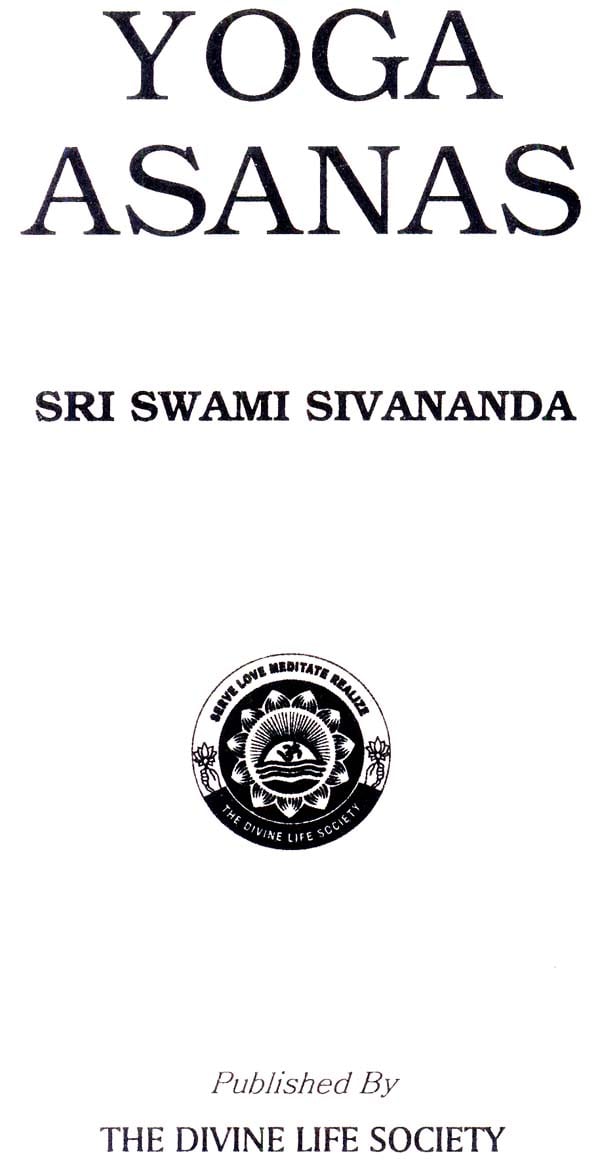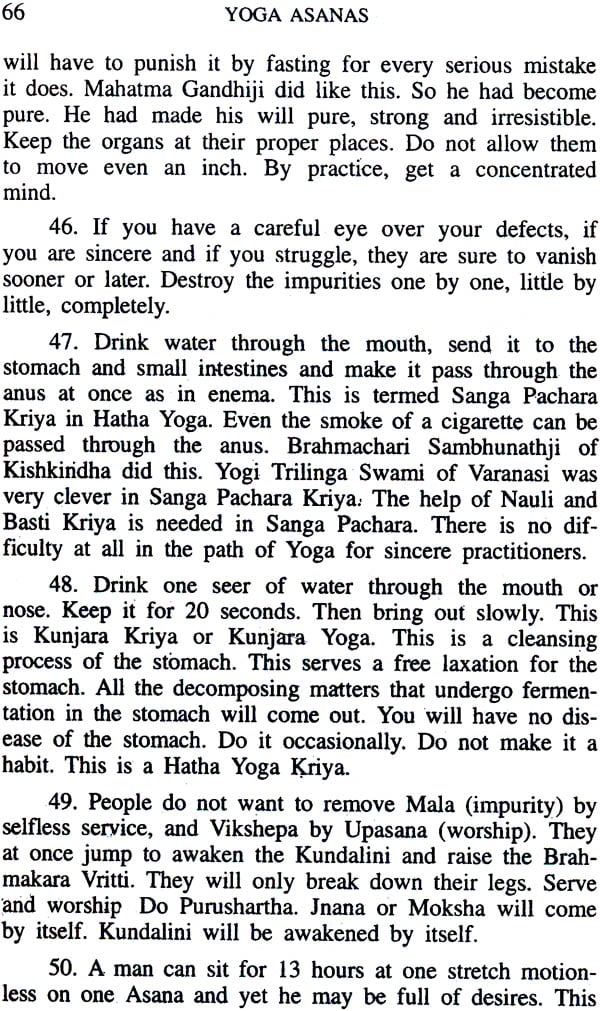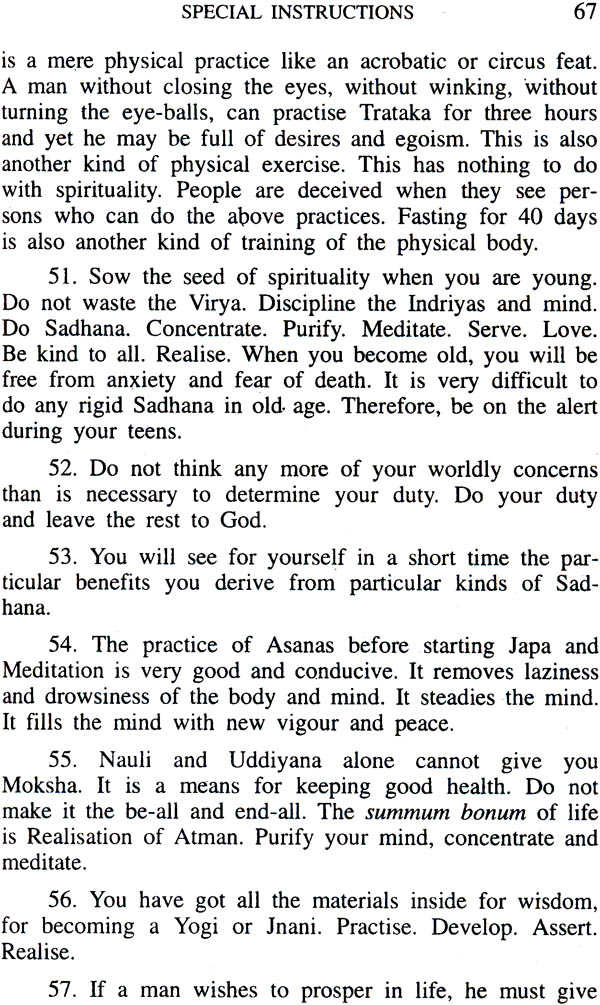
YOGA ASANAS
Book Specification
| Item Code: | IDF819 |
| Author: | Sri Swami Sivananda |
| Publisher: | THE DIVINE LIFE SOCIETY |
| Language: | English |
| Edition: | 2004 |
| ISBN: | 8170520088 |
| Pages: | 164 (B & W Illus: 52) |
| Cover: | Paperback |
| Other Details | 8.5" X 5.5" |
| Weight | 220 gm |
Book Description

Born on the 8th September, 1887, in the illustrious family of Saga Appayya Diskhita and several other renowned saints and savants, Sri Swami Sivananda had a natural flair for a life devoted to the study and practice of Vedanta. Added to this was an inborn eagerness to serve all and an innate feeling of unity with all mankind.
His passion for service drew him to the medical career; and soon he gravitated to where he thought that his service was most needed. Malaya claimed him. He had earlier been editing a Health Journal and wrote extensively on health problems. He discovered that people needed right knowledge most of all; dissemination of that knowledge he espoused as his own mission.
It was divine dispensation and the blessing of God upon mankind that the doctor of body and mind renounced his career and took to a life of renunciation to qualify himself for ministering to the soul of man. He settled down at Rishikesh in 1924, practiced intense austerities and shone as a great Yogi, Saint, Sage and Jivanmukta.
In 1932 he started the Sivanandashram. In 1936 was born The Divine Life Society. In 1948 the Yoga-Vedanta Forest Academy was organized. Dissemination of spiritual knowledge and training of people in Yoga and Vedanta were their aim and object. In 1950 he undertook a lightning tour of India and Ceylon. In 1953 he convened a 'World Parliament Reliogions'. He is the author of over 300 volumes and has disciples all over the world, belonging to all nationalities, religions and creeds. To read his works is to drink at the fountain of Wisdom Supreme. On 14th July, 1963 he entered Mahasamadhi.
I bow with folded hands, crores of times, to Brahman, the destroyer of all fears, miseries and tribulations of those who betake themselves to Him, which though absolutely un- born (Aja) appears by the power of His greatness to pass into birth, which appears as if in motion, though always at rest (Achala), and which, though one, (Ekam-eva-advitiyam Brahma) appears as many to those whose inner vision is dimmed by the perception of an endless variety of illusory appearances.
I salute Thee, first Lord Siva (Adinatha), who taught to Parvati the Hatha- Vidya that is a step to the attainment of the most excellent Raja Yoga.
Goraksha and Matsyendra knew well the Hatha- Vidya. Yogi Swatmarama learnt it from them by their favour. To those who wander about in the darkness of this science or branch of Yoga unable to obtain any knowledge of Hatha Yoga, the most merciful Swatmarama Yogi offers the light of Hatha- Vidya.
The goal of life is Self-realisation. All systems of Indian philosophy have one goal in view, the liberation of the soul through perfection.
Every man wants happiness. He shuns pain. No one teaches anyone to seek happiness. It is the innate, inherent Svabhava (nature) of everyone to seek happiness. Ananda is embodiment of one's own nature.
Gratification of desires cannot bring in real peace of mind though the nerves are tickled for a second. Just as ghee when poured over the fire aggravates the fire, so also enjoyment intensifies a desire and makes the mind all the more restless. How can you expect real, lasting happiness from objects that are conditioned in time, space and causa- tion and so are Vinasi (perishable) and Anitya (impermanent)?
The happiness that you get from sensual objects is fleeting and transitory. For a philosopher it is no happiness at all. It is like scratching the skin when you get itching. Sensual happiness is attended with severe exertion, sin, fear, pain, worry and several evils.
Amidst the din and boisterous bustle of worldly activities there come moments of tranquillity and peace when the mind, for the time being, however short it may be, soars above the filthy worldly things and reflects on the higher problems of life-viz., "Who am I? Whence? Where? Whither? Why of Universe?" etc. The sincere en- quirer becomes serious and extends his reflections. He begins to search and understand the truth. Discrimination dawns on him. He takes to the study of Atma-Jnana books, reflects, meditates, purifies his mind and eventually attains the highest knowledge of the Self. But the man whose mind is saturated with worldly Vasanas and cravings is quite heedless and is irresistibly carried away by the two currents of Raga-Dvesha and .tossed about helplessly in the tumul- tous Samsaric stream of birth and death with its con- comitant evils.
The spiritual path is thorny, precipitous and neverthe- less has been trodden by man of strong determination, un- daunted spirit and indomitable. energy. When once you make up your mind to tread the path, everything will become smooth and easy. You will have descent of Grace from the Lord. The whole spiritual world will back you up. The path will directly take you to realms of Infinite- Bliss, Supreme Peace, Eternal Sunshine-realms where three kinds of Tapa, cares, worries, anxieties and fear, which torment the soul here dare not enter, where all distinctions of caste, creed and colour vanish altogether in the one embrace of Divine Love and where desires and cravings find their full satiety. Just as one and the same coat will not suit Mr. John, Mr. Das or Mr. Pantulu, so also one path will not suit all people. There are four paths to suit people of four kinds of temperament. They all lead to the same goal, the attainment of ultimate Reality. Roads are different but the destination is the same. The four paths that are inculcated for the achieve- ment of this ultimate Truth from the different stand-points of the man of action, the man of devotion, the mystic man and the philosopher or the man of reason, are respectively termed Karma Yoga, Bhakti Yoga, Raja Yoga and Jnana Yoga.
The four paths are not antagonistic to one another, but, on the other hand, they are complementary. They only indi- cate that the different methods of the Hindu religion are in harmony with each other. Religion must educate and develop the whole man, his heart, intellect (head) and hand. Then only will he reach perfection. One-sided development is not commendable. Karma Yoga removes Mala, purifies the mind and develops the hand. Bhakti Yoga destroys Vikshepa and develops the heart. Raja Yoga steadies the mind and makes it one-pointed. Jnana Yoga removes the veil of ignorance (Avarana), develops will and reason and brings in knowledge of the Self. Therefore one should prac- tise the four Yogas. You can have Jnana Yoga as the centre and the other Yogas as auxiliaries to get rapid progress in the spiritual path.
The word 'Yoga' means union between Jivatma and Paramatma (individual soul and Supreme Soul). The science that teaches the way of acquiring this occult knowledge is called Yoga Sastra. Hatha Yoga concerns with the physical body and control of breath. Raja Yoga deals with the mind. Raja Yoga and Hatha Yoga are necessary counterparts of each other. No one can become a perfect Yogi without a knowledge of the practices of both. Raja Yoga begins where properly practised Hatha Yoga ends.
Hatha is considered to be a compound word formed of two syllables 'Ha' and 'tha': 'Ha' means the moon (Ida Nadi) and 'tha' means the sun (Pingala). These correspond to the breaths, which flow through the left and right nostrils. Hatha Yoga teaches the way to unite the sun and the moon, the Prana and Apana through the regulation of breath.
Hatha Yoga is conducive to health and longevity. Its practice regulates the action of heart, lungs and brain. It promotes digestion and circulation of blood. Kidneys, liver and all other internal viscera work efficiently. It removes all sorts of diseases.
This book 'YOGA ASANAS' deals with 90 poses of the body with important Bandhas and Mudras and system of Pranayamas, prescribed by the Yoga Sastras. Pranayama goes hand in hand with Asanas. The first two accessories of Yoga are Yama and Niyama. Asana is the third Anga of Ashtanga Yoga, while Pranayama is the fourth Anga. The wise Rishis of yore had formulated these as aids to spiritual culture and preservation of a high standard of health, vigour and vitality.
| Pages | ||
| Publishers' Note | v | |
| Devi Stotra | vii | |
| Guru Stotra | vii | |
| Para Puja | viii | |
| A Universal Prayer | ix | |
| Introduction | x | |
| Good-Vision (Swami Karunandanda) | xvii | |
| Flexibility (Swami Karunandanda) | xxi | |
|
| ||
| Surya Namaskara | 3 | |
| Prayer to the Sun | 5 | |
|
| ||
| General Instructions | 7 | |
| 1 | Padmasana | 8 |
| 2 | Siddhasana | 10 |
| 3 | Svastikasana | 12 |
| 4 | Sukhasana | 12 |
|
| ||
| 5 | Sirshasana | 14 |
| 6 | Sarvangasana | 17 |
| 7 | Halasana | 20 |
| 8 | Matsyasana | 21 |
| 9 | Paschimottanasana | 23 |
| 10 | Mayurasana | 24 |
| 11 | Ardhamatsyendrasana | 27 |
| 12 | Salabhasana | 28 |
| 13 | Bhujangasana | 30 |
| 14 | Dhanurasana | 31 |
| 15 | Gomukhasana | 33 |
| 16 | Vajrasana | 34 |
| 17 | Garudasana | 37 |
| 18 | Urdhva Padmasana | 38 |
| 19 | Padangushthasana | 39 |
| 20 | Trikonasana | 40 |
| 21 | Baddha Padmasana | 41 |
| 22 | Padahastasana | 43 |
| 23 | Matsyendrasana | 45 |
| 24 | Chakrasana | 47 |
| 25 | Savasana | 48 |
|
| ||
| 26 | Janusirshasana | 50 |
| 27 | Tolangulasana | 51 |
| 28 | Garbhasana | 51 |
| 29 | Sasangasana | 52 |
| 30 | Simhasana | 52 |
| 31 | Kukkutasana | 53 |
| 32 | Gorakshasana | 53 |
| 33 | Kandapidanasana | 53 |
| 34 | Sankatasana | 54 |
| 35 | Yogasana | 54 |
| 36 | Utkatasana | 55 |
| 37 | Jeshthikasana | 55 |
| 38 | Adhvasana | 56 |
| 39 | Urdhvapadasana | 56 |
| 40 | Ushtrasana | 56 |
| 41 | Makarasana | 56 |
| 42 | Bhadrasana | 56 |
| 43 | Vrischikasana | 56 |
| 44 | Yoga Nidrasana | 57 |
| 45 | Ardhapadasana | 57 |
| 46 | Kokilasana | 57 |
| 47 | Karnapidasana | 57 |
| 48 | Vatayanasana | 58 |
| 49 | Paryankasana | 58 |
| 50 | Mritasana | 58 |
| Special Instructions | 59 | |
| Yogic Recipe | 72 | |
|
| ||
| 1 | Maha Mudra | 75 |
| 2 | Yoga Mudra | 76 |
| 3 | Khechari Mudra | 76 |
| 4 | Vajroli Mudra | 77 |
| 5 | Viparitakarani Mudra | 77 |
| 6 | Sakti Chalana Mudra | 78 |
| 7 | Maha Vedha | 78 |
| 8 | Maha Bandha | 79 |
| 9 | Mula Bandha | 79 |
| 10 | Jalandhara Bandha | 80 |
| 11 | Uddiyana Bandha | 80 |
| 12 | Yoni Mudra | 81 |
|
| ||
| Exercise No. 1 | 82 | |
| Exercise No. 2 | 83 | |
| 1 | Kapalabhati | 83 |
| 2 | Suryabheda | 84 |
| 3 | Ujjayi | 85 |
| 4 | Sitkari | 85 |
| 5 | Sitali | 86 |
| 6 | Bhastrika | 86 |
| 7 | Bhramari | 88 |
| 8 | Murcha | 89 |
| 9 | Plavini | 89 |
| 10 | Kevala Kumbhaka | 89 |
| Benefits of Pranayama | 90 | |
| Hints on Pranayama | 91 | |
| | ||
| Kundalini | 95 | |
| Ida, Pingala, Sushumna and | ||
| Shat-Chakras | 95 | |
| Abhyasa-Krama and Dinacharya | 96 | |
| Important Hints | 98 | |
| Yoga Asanas | 100 | |
| Glossary | 110 | |


Click Here for More Books Published By Divine Life Society, Rishikesh





